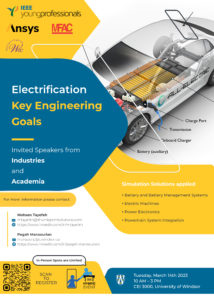Electrification Key Engineering Goals
Date: Tuesday, March 14th, 10 AM – 3 PM
Location: Hybrid event, in person (CEI 3000) , University of Windsor, and online (Microsoft Teams)
To lead the EV market, organizations must meet key engineering goals on performance safety and cost.
Performance:
One of the concerns of a potential buyer is how far an electric vehicle can travel without a need for charging. The goal is to reduce the range of anxiety. The preferred range is over 400 miles while today it is 60-300 miles for EVs. Improve battery life and compare it to vehicle life(about 10 years). Today battery warranty is about 7-8 years. Increase battery and motor power density, and create differentiators in terms of comfort like reducing noise and vibration.
Safety:
Safety is the most important criterion for EVs. Even a single battery fire could turn public opinion against electric mobility and set back Electric Vehicle development. Vehicles and components need to be tested against industry standards for compliance and reliability. The switching device in EV leads to ripple and overvoltage, which may lead to the failure of dielectrics. Also, the switching device results in emissions, which we need to ensure are below regulatory standards.
Cost:
Affordability is one of the factors for mass adoption. The production cost of EVs should be equivalent to or lower than that of IC Engine vehicles. 30-40% cost of EVs is Battery, and it’s expected to reduce battery costs by <$100 / KW-hr. With the increase in electronics, software development costs and time have increased, and there is a need to improve development productivity and reduce manual error.
What will be discussed in this educational seminar:
How Simulation Solutions Applied in Four Critical Areas?
- BATTERY & BATTERY MANAGEMENT SYSTEMS
- ELECTRIC MACHINES
- POWER ELECTRONICS
- POWERTRAIN SYSTEM INTEGRATION
Registration link:


